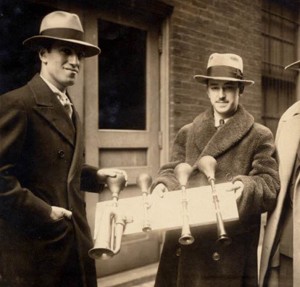Taxi!
Perhaps you saw the recent article in The New York Times under the provocative headline “Have We Been Playing Gershwin Wrong for 70 Years?” It’s about his beloved An American In Paris, a symphonic tone poem that features the distinctive sounds of French taxi horns. The inimitable honkers are just one of the ways Gershwin evokes the bustle and atmosphere of the French capital as it sounded in 1928. Gershwin reportedly spent a lot of time tooting on actual taxi horns (the old-fashioned kind with the squeeze bulb) before choosing the four he wanted.
Then, for unknown reasons, the composer did something that created a long-running musical mystery: In his score for American, he indicated which taxi horn should play which part with a set of circled letters: A, B, C, and D.
Over time, those designations came to be seen as the musical pitches A, B, C, and D. But new scholarly research now claims that those letters were just labels, not pitches. And the researchers point to a 1929 RCA Victor recording of American credited to the Victor Symphony Orchestra, under the supervision of Gershwin himself, as proof. Sure enough, the taxi horns on that recording sound very different from the ones we’ve been hearing for decades in concert halls, on recordings, in movie soundtracks, and in the current hit Broadway show. The pitches are more like A-flat and B-flat above Middle C, a D above that, plus an A-flat below Middle C. Producing that lower note would require a longer horn than the ones orchestras have been using for years.
This bit of musical detective work created a stir in the symphonic world. But it didn’t quite convince Christopher Deviney, Principal Percussion for the Philadelphia Orchestra. When the news broke, they were just a couple of weeks away from performing An American in Paris, and those taxi horns are his responsibility. (The Philadelphia Orchestra has its own set of American In Paris taxi horns? Mais oui! Complete with travel case.)
While Deviney found the Times story intriguing, he didn’t think a single recording justified changing the horns. For one thing, the taxi horns we’ve grown used to are pretty much in tune with what the rest of the orchestra is playing.
But then Chris heard from an old friend, a fellow percussionist in the Chicago Symphony. His father had played percussion with the Cincinnati Symphony, including on a performance of American in Paris shortly after it was written. Gershwin himself had brought the taxi horns to Cincinnati for the occasion. Chris’s friend has the photo to prove it:
That’s Gershwin on the left, seemingly about to honk a taxi horn that’s a whole bunch longer than the other ones. Long enough to produce that low A-flat.
That was all it took to convince Deviney that the “wrong horns” story was legit, and he should find some new horns. (That and word that his conductor, Yannick Nézet-Séguin, wanted to try the new pitches.)
Chris called Steve Weiss Music in Willow Grove, PA, one of the world’s leading suppliers of percussion instruments. They could order him taxi horns in A-flat, B-flat, and D above Middle C. But the long one in a low A-flat below middle C? Sorry; nobody makes it.
Undeterred, Chris told Steve Weiss to do their best. And a few days later, he went to Willow Grove to check on progress. Three of the horns were on order. And just for grins, a store employee had rummaged through a drawer of miscellaneous horns, and voila! There was a bicycle horn in the missing pitch. Problem solved.
Or was it? Have you ever waited for a taxi that “never came”? That’s the case with the three taxi horns Chris ordered. They didn’t arrive in time for the Philadelphia Orchestra’s performance of An American in Paris, so the old set of horns just had to do.
When the new horns finally show up, Deviney doesn’t think audiences are going to mind them, no matter how unfamiliar (and more dissonant) they may sound. After all, they’re supposed to represent the cacophony of traffic in the middle of Paris. “It’s not like we’re taking taxi horns and trying to get melodies out of them.”
In fact, the new/old taxi horns should feel right at home with The Philadelphia Orchestra. That Victor recording from way back in 1929, the one the scholars used to back up their theory about the horns? The label reads “The Victor Symphony Orchestra with George Gershwin,” but at least one source says, it was actually members of The Philadelphia Orchestra.
Plus ça change…

